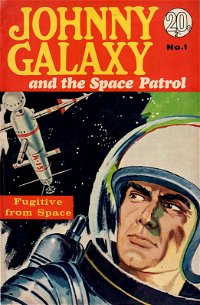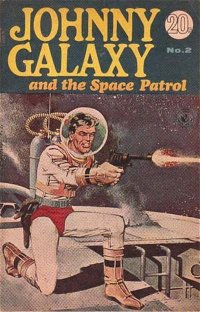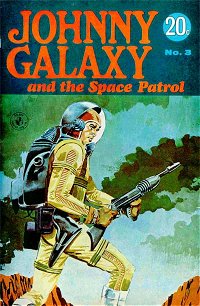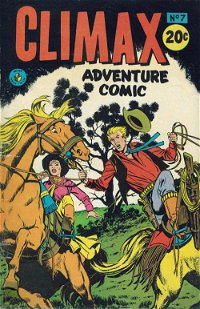Johnny Galaxy and the Space Patrol by James Zee
Johnny Galaxy lands in Australia
Johnny Galaxy and the Space Patrol was among the earliest work from Spanish agency Selecciones Ilustradas (SI) to be printed by KG Murray.
The feature was first published in Australia in its own title (1967-1968) composed almost entirely of Johnny Galaxy stories. When that series ended with four issues, the feature moved to Climax Adventure Comic (1968–1973) and finally Super Giant (1973), anthologies that hosted work from a wide array of sources.11Alongside Selecciones Ilustradas stories, reprints in Climax Adventure Comic and Super Giant included ACG, Ajax-Farrell, Atlas/Marvel, Charlton, Comic Media, Fawcett,...
The Australian series has striking pulp-inspired covers22See Spiros' reflections at notesfromthejunkyard.blogspot.com.... that were also printed internationally and probably acquired as part of the Johnny Galaxy package.33The cover of Johnny Galaxy and the Space Patrol 4 is also used on the Portugese issue, Naves... However, these anonymous paintings do not depict Johnny Galaxy; rather it is a generic astronaut in a different space suit for each image.
The seven-page Johnny Galaxy stories evoke the atmosphere of DC's 1960s Adam Strange stories, with a threat quickly introduced that Johnny overcomes by wit and bravery, often accidentally aided by his companions. Many episodes are numbered,44See the Johnny Galaxia story list at AusReprints.... suggesting a publication order, but they largely lack continuity and are not printed in order. Johnny's profession, associates and base of operations are fluid.
Johnny's origin begins on Earth, where he is a bored forest ranger in the Rockies dreaming of being a space pilot. He encounters a dying alien from Altair who passes on his advanced spaceship and a memory-transferring helmet.55The untitled origin of Johnny Galaxy, printed in Super Giant 2, 1973.... Within a few episodes, Johnny has a headquarters, his outfit is a uniform (with a distinctive triangular emblem) and he associates with an investigative Earth agency, the Space Patrol66The earliest reference to the Space Patrol that I've identified is the story "The Galactic Mind Readers", printed in
Johnny soon gains a young "co-pilot", a Sirion boy called Truck.88The episode "The Castle No One Returns From" in Johnny Galaxy and the Space Patrol 1, 1967 refers to... Most stories show Johnny and Truck stumbling across crises or responding to distress calls that lead to adventures. Some stories show Johnny as a solo explorer, which may occur after Truck's parents tell him he must "stay home".99As explained in "The Greed of the Robots", printed in Johnny Galaxy and the Space Patrol 4, May 1968....
Johnny Galaxy was created as Johnny Galaxia by Josep M. Beá1010Josep Maria Beà i Font was born in Barcelona in 1942. He did his first work for Selecciones Ilustradas at... (b. 1942) and Blay Navarro1111Beá reports that he was assisted by Blay Navarro, who was the accountant at Selecciones Ilustradas. This may be the... (b. ?) for Spanish agency Selecciones Illustradas (SI) in 1959. It was quickly sold to the UK, but became one of the first SI works to recieve multiple international printings,1212Also in international publication at this time was the western Riffle (1958-1960), created by SI head Josep Toutain and... rather than being owned exclusively by a single publisher. The series received broad publication across the globe in the early to mid-1960s, with its introduction into Australia comparatively late.
This early experimentation with syndication1313For further information, see the AusReprints article on Sunday.... may account for the variability in the feature's plotting, artwork and even naming—with the title ranging from Johnny Galaxy, Johnny Galaxia and Johnny Galaxie to the unpredictable Space Ace and Alan Ford.



